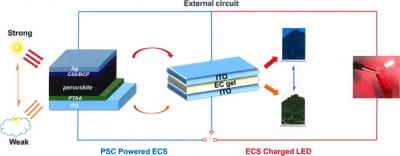Scientists from the Southern University of Science and Technology in China have developed an automatic light-adjusting electrochromic device (ECD), powered by a perovskite solar cell (PSC), which they say can be used for all-day intelligent-curtains, and advanced electronic displays.

Electrochromic devices are able to reversibly change colors in response to an electric field and generally consist of multi-layer structures with transparent conductors, electrochromic films, ion conductors, and ion storage films. Although these devices are capable of modulating their light absorption under a small driving voltage, the requirement for external electrical supplies causes response-lag.
The two devices are also said to have high optical contrasts, excellent light sensitivity, and sufficient energy harvesting and storage.
A perovskite solar cell technology was chosen, the researchers specified, due to its high photoelectric conversion efficiency, low cost, and mature assembly technique.
The inverted solar cell was fabricated by depositing a perovskite layer on a hole transporting material based on poly(triarylamine) (PTAA). The cell showed an open-circuit voltage of 1.02'V, a short-circuit current of 22.8'mA/cm2 and a fill factor of 78.4%. 'The perovskite solar cells generated the voltage and current, making the electrochromic change from transparent to a colored state, indicating the solar cell could power the electrochromic device and the electrical power is stored in the ECD,' the scientists explained.
The perovskite cell, when the sunlight is stronger, can drive the electrochromic device into a dark state, which would prevent too much light from entering a building. When sunlight is weak, the installed device is driven into a bright state, which allows more light to enter. 'These extraordinary results suggest huge potentials of PSC-powered ECDs being applied for all-day intelligent-curtains and advanced electronic displays,' the scientists explained. 'However, considering the latent toxicity of DPV and MPV, strict sealing work would be required if PSC-powered ECDs were applied in modern buildings and automobiles.'
The researchers stated that the perovskite cell may also be used for other applications. 'We are thinking to use the solar cell with a supercapacitor in the future,' research co-author Fengyu Su concluded.

